Abstract
Haze constitutes a pivotal meteorological variable with notable implications for photovoltaic power forecasting. The presence of haze is anticipated to lead to a reduction in the output power of photovoltaic plants. Therefore, achieving precise forecasts of photovoltaic power in hazy conditions holds paramount significance. This study introduces a novel approach to forecasting photovoltaic power under haze conditions, leveraging ground-based cloud images. Firstly, the aerosol scattering coefficient is introduced as a pivotal parameter for characterizing photovoltaic power fluctuations influenced by haze. Additionally, other features, such as sky cloud cover, color attributes, light intensity, and texture characteristics, are considered. Subsequently, the Spearman correlation coefficient is applied to calculate the correlation between feature sequences and photovoltaic power. Effective features are then selected as inputs and three models—LSTM, SVM, and XGBoost—are employed for training and performance analysis. After comparing with existing technologies, the predicted results have achieved the best performance. Finally, using actual data, the effectiveness of the aerosol scattering coefficient is confirmed, by exhibiting the highest correlation index, as a pivotal parameter for forecasting photovoltaic output under the influence of haze. The results demonstrate that the aerosol scattering coefficient enhances the forecast accuracy of photovoltaic power in both heavy and light haze conditions by 1.083% and 0.599%, respectively, while exerting minimal influence on clear days. Upon comprehensive evaluation, it is evident that the proposed forecasting method in this study offers substantial advantages for accurately predicting photovoltaic power output in hazy weather scenarios.
1. Introduction
Electricity stands as a cornerstone for a country’s technological advancement and economic prosperity, crucial for achieving rapid urbanization and industrialization. As energy demand escalates, so does the need for power generation and distribution [1]. Solar energy, classified as a green and clean energy source, holds the promise of mitigating pollution and greenhouse gas emissions. It offers an avenue to diminish reliance on fossil fuels, thereby fostering sustainable development. However, photovoltaic power generation is inherently characterized by its randomness and fluctuations, rendering it susceptible to the vagaries of the climatic environment. The prevalence of frequent haze weather in recent years has cast a shadow on the stability and dependability of photovoltaic system operation [2].
Haze constitutes a significant component of atmospheric aerosols. During hazy weather conditions, atmospheric aerosols attenuate direct solar radiation as the haze traverses the atmosphere, leading to an increase in scattered radiation. Consequently, this diminishes the irradiation intensity received by photovoltaic panels, thereby reducing photovoltaic output power. In order to investigate the specific impact of aerosols, such as haze, on photovoltaic power generation, the authors of [3] employed analysis of variance to demonstrate that photovoltaic power generation during haze conditions decreased by 17.8% compared to normal days. The study conducted in [4] primarily centered on examining the effects of aerosols on photovoltaic production, utilizing atmospheric radiation transfer models focused on sub-Saharan Africa and revealing a reduction in PV power generation ranging from 2% to 48%. In [5], researchers delved into the effects of aerosols on timescales spanning from seasonal to multi-decade periods in photovoltaic production. This analysis was predicated on aerosol and climate simulations, with results indicating that aerosols influenced 12% to 16% of the average annual productivity of PV systems, contingent on the type of installation. Consequently, during hazy weather, the actual output of photovoltaic power generation deviates significantly from the predicted output, failing to align with the intrinsic requirements of the power system. Enhancing the forecast accuracy of photovoltaic power in hazy conditions holds positive implications for the optimal dispatch of regional energy resources.
At present, scholars have conducted extensive research on photovoltaic power forecasting. However, there remains a scarcity of studies specifically addressing photovoltaic power forecasting in hazy weather conditions. In [6], the authors utilized a BP neural network to establish a model, incorporating haze as one of the influencing factors. This approach demonstrated that an increase in haze factors could enhance forecast accuracy, as confirmed by actual photovoltaic power generation system data. The researchers in [7] recognized the attenuation effect of solar irradiance during hazy conditions. They employed a machine learning approach to develop an estimation model for atmospheric aerosol optical thickness based on particulate matter concentration. Ultimately, this model, combined with forecasts of particulate matter concentration and weather information, enabled ultra-short-term predictions of photovoltaic output power. However, it is important to note that when employing statistical methods for forecasting photovoltaic power in hazy weather, a substantial volume of accurate historical data and precise air pollution data are required. Obtaining such data can be challenging, thus imposing significant limitations on the applicability of statistical methods [8,9]. In the study mentioned in [10,11], a clear-sky model based on atmospheric radiation, combined with parameters related to aerosol optical thickness, was used to calculate the irradiance intensity reaching the surface of photovoltaic components. Subsequently, photovoltaic power generation was predicted through photoelectric conversion. This method is suitable for photovoltaic power forecasting in hazy environments. However, it should be noted that obtaining real-time data on atmospheric aerosol optical thickness can be challenging, rendering this method less practical.
In the field of ultra-short-term forecasting for photovoltaic power, the integration of ground-based cloud imagery with various predictive techniques has emerged as a crucial research direction. Ground-based cloud imagery provides real-time information on atmospheric conditions above photovoltaic power stations and short-term cloud distribution. Compared to satellite imagery, it boasts superior temporal and spatial resolution, allowing for minute-by-minute calculations and forecasts of photovoltaic power output. For instance, features extracted from ground-based cloud imagery, such as cloud-coverage [12] and cloud-motion trends [13,14], can serve as inputs for predictive models. However, there has been no prior research in the existing research focused on using ground-based cloud imagery for forecasting PV power generation during hazy conditions. Given the existing research landscape outlined above, this study aims to establish an ultra-short-term forecasting method for photovoltaic power under hazy weather conditions, using ground-based cloud imagery. The objective is to provide a basis for the short-term scheduling of photovoltaic power generation in such weather conditions and the novelty of this research lies in introducing cloud image features, such as the aerosol scattering coefficient and cloud coverage, which have a significant impact on photovoltaic output in hazy weather. This study marks the first instance of utilizing ground-based cloud imagery to address the challenge of the ultra-short-term forecasting of photovoltaic power under hazy conditions. The remaining sections of this paper are organized as follows: Section 2 provides a qualitative analysis of the impact of haze on photovoltaic power generation. In Section 3, the ground cloud data and its preprocessing procedures are outlined. Section 4 focuses on extracting the pertinent characteristics that influence photovoltaic output from ground-based cloud imagery during haze weather conditions. In Section 5, three predictive models and their corresponding performance evaluation metrics are presented. Section 6 encompasses an illustrative analysis, offering a comparative assessment of prediction outcomes from different models. Additionally, experiments are designed to validate the effectiveness of aerosol scattering coefficients. Finally, conclusions and future prospects are presented in Section 7.
2. Analysis of the Impact of Haze on Photovoltaic Power
Haze weather differs significantly from other extreme weather conditions like rain and snow, as per meteorological definitions. When haze weather sets in, a multitude of minute aerosol particles remain suspended in the air, creating a uniform state of turbidity. This leads to diminished visibility, with horizontal visibility often falling below 10.0 km, and relative humidity dropping below 80%. Haze can persist for days, casting a distant sky in hues of yellow or orange-gray.
In haze weather conditions, atmospheric aerosols emerge as pivotal factors significantly impacting photovoltaic output efficiency. To directly observe the attenuation of photovoltaic power during haze, three days were selected within a month based on the forecasts of numerical meteorological parameters, as well as assessments of sky color and cloud type from corresponding ground-based cloud images. These days represent states of heavy haze, light haze, and clear conditions without haze. Subsequently, Figure 1 illustrates the photovoltaic output power curve from 07:00 to 18:00 (UTC/GMT + 08:00) on these three days.
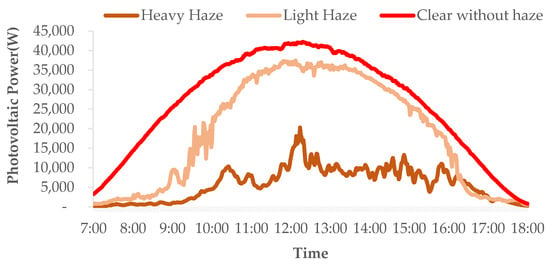
Figure 1.
Comparison of photovoltaic output curves for heavy haze, light haze, and clear day.
As is shown in Figure 1, heavy haze leads to a significantly greater attenuation of photovoltaic power compared to light haze. Thus, when haze reaches a specific threshold, it emerges as the predominant factor in diminishing photovoltaic power generation. Table 1 presents the initial ground-based cloud images captured at 09:30, 12:00, and 14:30, offering a visual depiction of distinct sky conditions across these three weather scenarios.

Table 1.
Ground-based cloud images at different time points under three types of weather conditions.
3. Ground-Based Cloud Image Introduction
The TSI-440 all-sky imager, a comprehensive, automated full-color imaging system, has been developed and manufactured by Yankee Environmental Systems. This equipment is proficient in real-time observation and the capture of the sky’s condition throughout daylight hours, even amidst varying weather circumstances. Primarily deployed in cloud cover and weather monitoring, aviation meteorology, atmospheric space surveillance, and air pollution research, the all-sky imager demonstrates commendable temporal and spatial resolution. Notably, it enables more precise cloud cover assessments compared to satellite observations. The all-sky imager utilized in this study is situated within the teaching building of Tianjin University, boasting a temporal resolution of 0.5 min and producing images at a size of 640 × 480 pixels.
Figure 2 displays the acquired ground cloud image, encompassing both valid and invalid information. Within the circular imaging area, valid information pertains solely to the cloud and sky while invalid information comprises primarily of the shadow band, ground state, and camera bracket. To ensure that the identification process of the sky clouds remains unaffected by the invalid information and to optimize the efficiency of feature extraction, preprocessing of the image is essential.
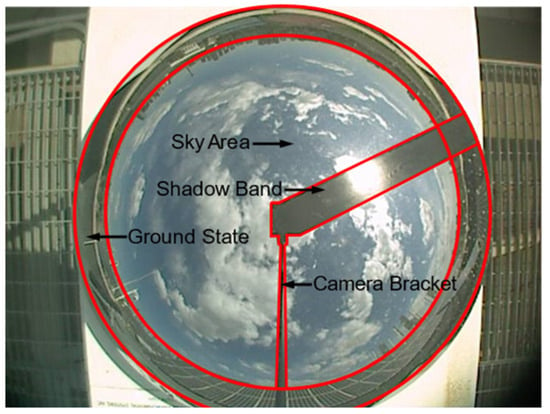
Figure 2.
Ground-based cloud image.
The preprocessing of the foundational cloud image involves three stages. Firstly, considering potential interferences during the CCD camera capturing process, such as photon and scattering noise, as well as potential atmospheric particle scattering affecting the spherical mirror’s clarity, a denoising algorithm is applied to enhance image quality. Subsequently, a mask is deployed to conceal the ground state and ground components, effectively eliminating invalid information and preserving only the sky area. Finally, an algorithm is employed to identify and rectify the shadow tape and lens arm, mending the respective areas. Following this preprocessing, the resultant sky area is depicted in Figure 3.

Figure 3.
Preprocessing result.
In this study, the atmospheric aerosol scattering coefficient features are extracted from the denoised images. All other features are obtained from images processed through three sequential stages.
4. Feature Extraction
In hazy weather conditions, the primary factors influencing the output power of photovoltaic generation are alterations in the atmospheric aerosol concentration. This section addresses the atmospheric scattering effect by leveraging digital image processing technology. It establishes a definition for the scattering coefficient, which serves as an indicator of atmospheric aerosol concentration. Additionally, this section conducts the extraction of pertinent features from ground-based cloud imagery, including cloud cover, color attributes of the sky region, texture characteristics, and light intensity, all of which exert an impact on photovoltaic output.
4.1. Aerosol Scattering Coefficient
In accordance with the atmospheric scattering model, the cloud image captured by the CCD camera not only records the direct attenuation process of atmospheric aerosols on incident light but also encompasses multiple reflection and refraction processes occurring between ambient light and atmospheric aerosols. Through observations of ground-based cloud images in hazy weather conditions, the following insights are gleaned:
Under clear sky conditions, adhering to the fundamental color theories of R, G, and B, the brightness value of the B component in the sky region of the cloud image is the most pronounced, rendering an overall impression of vivid blueness. However, with the onset of hazy weather, discernible shifts in atmospheric conditions occur. As airborne particles possess diameters larger than the wavelength of light, light experiences scattering phenomena, such as Mie scattering. Consequently, the sky’s hue transforms into shades of yellow or orange-gray, significantly influencing the pixel values across all three channels in the ground-based cloud image. Furthermore, atmospheric aerosols exert a notable attenuating effect on sunlight, resulting in reduced atmospheric visibility, diminished cloud image clarity, and heightened disparities among the R, G, and B channels in the sky region of the image.
The RGB curves of pixels along the red line in the ground-based cloud image are illustrated for both clear and hazy weather conditions, as depicted below:
In Figure 4b, it can be observed that during clear sky conditions, the blue channel component exhibits the highest value while the red component shows the lowest. During such periods, the sky is primarily influenced by Rayleigh scattering, with the scattering ratio of blue light being higher than that of red light. As a result, the sky appears blue while the channel values for ground conditions exhibit no significant pattern. Moving on to Figure 5b, under hazy atmospheric conditions, the atmosphere experiences an increase in aerosol concentration, leading to intensified atmospheric scattering phenomena. This leads to a greater disparity in pixel values between the red and blue channels in the sky region. Additionally, ground conditions are also influenced by the scattering of atmospheric aerosol particles, resulting in a trend in the red and blue channel pixels that align with the sky region.
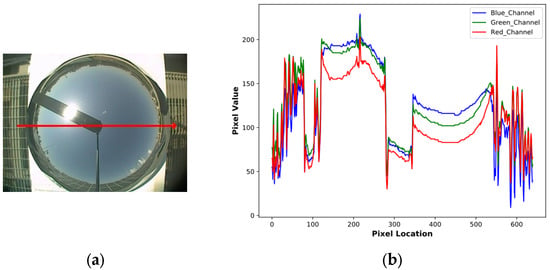
Figure 4.
Three-channel pixel change curve on the red arrow of the clear sky cloud map: (a) cloud image of clear weather; (b) curve of pixel value.
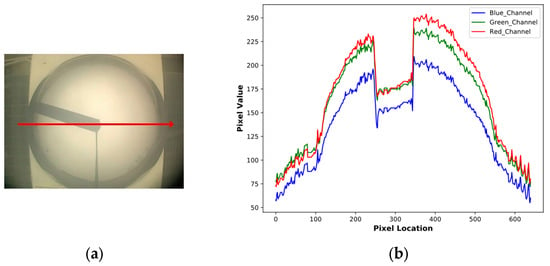
Figure 5.
Three-channel pixel change curve on the red arrow of the hazy sky cloud map: (a) cloud image of clear weather; (b) curve of pixel value.
Given the aforementioned observations, in order to gauge the extent of atmospheric aerosols, the channel scattering map (CSM) is defined in Equation (1) and Equations (2)–(4) provide further explanation:
among them,
where , , and , respectively, mean the average value of the three cloud channels R, G, and B. The value of is set to e-12, in order to ensure that the denominator is not 0.
This formula quantifies the disparity in the pixel channels within the cloud image, thereby capturing the scattering effect induced by aerosols. Following the computation of the channel scattering map, the scattering coefficient is represented in Equation (5):
Among these parameters in Equation (5), represents the standard deviation of the CSM, providing a metric for assessing the scattering dispersion variance among different pixels. Meanwhile, denotes the average of the channel scattering map, offering a gauge of the average scattering intensity of atmospheric aerosol particles in response to light. A small indicates a low scattering dispersion across the overall ground-based cloud image, signifying elevated atmospheric aerosol content and heavy hazy weather conditions. Conversely, a large value of implies that pixels in the ground-based cloud image are minimally impacted by aerosol particle scattering, resulting in a heightened degree of dispersion in channel scattering levels. This suggests a lower concentration of atmospheric aerosols and a greater likelihood of clear skies. Figure 6 presents four cloud images captured under varying weather conditions, including hazy and clear weather, along with the corresponding scattering coefficient calculation outcomes.
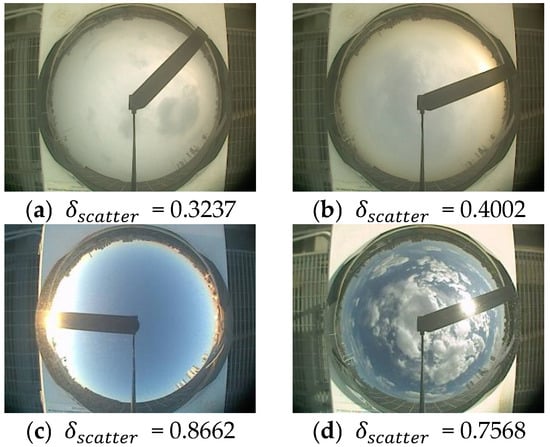
Figure 6.
Scattering coefficient of cloud images (a–d) in different weather.
Observations have revealed a correlation between the scattering coefficient and the concentration of atmospheric aerosols. Findings indicate that higher levels of atmospheric aerosols result in a lower scattering coefficient, approaching 0, while lower levels lead to a higher scattering coefficient, approaching 1. Through a comprehensive analysis of experiments conducted under various weather conditions, a critical threshold of 0.55 is established as the benchmark. Additionally, greater than 0.55 signifies clear sky conditions and excellent air quality, with larger values indicating a lower concentration of atmospheric aerosols. Conversely, below 0.55 implies unclear sky conditions, such as those experienced during hazy weather events, with a lower value signifying a higher concentration of atmospheric aerosols and subsequently diminished air quality.
4.2. Other Features
In hazy weather conditions, beyond the aerosol scattering coefficient, the atmospheric scattering effect also influences the cloud cover, light intensity, and texture characteristics of the sky captured in the ground-based cloud image.
4.2.1. Cloud Cover
The energy harnessed for solar electricity is derived from the sun, which transmits energy to the earth through solar radiation. This radiation undergoes absorption, reflection, and scattering within the atmosphere due to air molecules, cloud particles, and aerosol particles. By the time it reaches the earth’s surface, it becomes attenuated. The scattered radiation, having traversed the atmosphere, constitutes a significant portion of the solar radiation that ultimately reaches the ground. This aspect is chiefly influenced by the angle of the sun’s altitude and is highly responsive to variations in clouds and aerosols within the atmosphere. Alterations in scattered radiation lead to changes in solar radiation, subsequently affecting photovoltaic power output. Thus, cloud cover serves as an effective metric for characterizing photovoltaic power.
Prior to cloud cover extraction, image segmentation is necessary. In a previous study [15], the maximum between-class variance method was employed for ground-based cloud image segmentation, utilizing clear sky image pairs. Meanwhile, in [16], the normalized red-blue ratio was used for image segmentation. However, in hazy weather conditions, atmospheric aerosols diminish atmospheric visibility, resulting in blurred cloud images. Additionally, the combined influence of aerosols and light exacerbates scattering effects. Consequently, the aforementioned methods are ill-suited for image segmentation during hazy weather. To address these challenges, this study proposes an enhanced cloud identification method, tailored especially for cloud mapping in hazy conditions, yielding superior results.
Initially, considering the diminished grayscale distribution of the cloud image during hazy weather conditions, in order to distinctly differentiate between cloud clusters and the sky in the image, this study draws inspiration from the approach outlined in [17]. The fast gradient domain-guided image filtering method is utilized to enhance image contrast and amplify details in specific regions. Moreover, to achieve more precise segmentation outcomes, a hierarchical area division technique is employed to discern the extent of sunlight interference within the ground cloud image. As illustrated in Figure 7, three concentric circles with radii R1 and R2, centered around the sun’s position, are delineated, segmenting the image into three layers. These radii and layer specifications are determined through a thorough analysis of extensive experimental data, ensuring stability and aligning with engineering application results. The first layer encompasses the circular area directly surrounding the sun and experiences the highest degree of sunlight influence. Typically, this area exhibits the most pronounced color variations and is susceptible to saturation. The second layer adopts a torus shape, positioned closely to the sun, yet is subject to lesser influence than the first layer, thus displaying relatively stable color variations. The third layer remains annular, experiencing further reduction in light impact and showcasing even more stable color variation.

Figure 7.
Hierarchical zoning.
Finally, the image segmentation is performed, employing the OTSU method.
Figure 8 displays the result of cloud cluster segmentation, comparing the proposed implementation with the enhancement method based on the YUV color space mentioned in [18] and the traditional histogram equalization approach.

Figure 8.
Image segmentation result: (a) the original image; (b) enhancement using traditional histogram equalization; (c) enhancement using Gaussian filter enhancement; (d) proposed.
In Figure 8b–d, white pixels within the sky region signify clouds while black pixels represent areas devoid of clouds. It can be shown that Figure 8d exhibits more effective cloud area identification in the image compared to (b) and (c).
Cloud cover plays a pivotal role in distinguishing various weather conditions. Lower cloud cover indicates clearer weather conditions while higher cloud cover suggests cloudier conditions. Photovoltaic power generation experiences fluctuations under both scenarios, just as it does during hazy weather. Therefore, cloud cover serves as a valuable predictor for photovoltaic power. It is quantified in the image as the ratio of cloud pixels to the total pixels within the sky area, as shown in Equation (6):
where represents the number of cloud pixels and denotes the total number of pixels within the sky area.
4.2.2. Color Features
Following investigation, it was observed that the disparity between the blue channel and the red channel is most pronounced in ground cloud images during haze events. As a result, the mean, variance, and skewness of the R and B channels are regarded as pivotal color attributes. The calculation formulas of them are given by Equations (7)–(9):
In Equations (7)–(9), represents the pixel value at coordinates (i,j) in either the blue or red channel while signifies the average value across valid areas of the blue or red channel in the image. Additionally, m denotes the number of rows in the image and n refers to the number of columns in the image.
4.2.3. Light Intensity
Light intensity, stands as a pivotal factor influencing photovoltaic output. Heightened light intensity signifies increased light energy absorption by the photovoltaic cell, resulting in higher power generation efficiency. The brightness of the sun region in the image can effectively reflect the intensity of the illumination. In order to quantify the illumination intensity, this study first locates the sunspot in the image. A region with a radius of 150 is set and the average brightness of the circular region (Component I in the HSI space) is calculated to measure the illumination intensity. The calculation is defined in Equation (10):
4.2.4. Texture Features
In cloud classification research [19], texture features are predominantly employed as classification attributes. Considering existing cloud classification feature extraction methods and their classification effectiveness, texture features are extracted based on the grayscale co-occurrence matrix from the ground-based cloud image. These encompass four texture characteristics: contrast, energy, entropy, and homogeneity.
Contrast measures the sharpness and depth of texture grooves in the image. In the context of ground-based cloud images, contrast signifies the clarity of the boundary between the cloud and the sky. A higher value indicates deeper grooves, resulting in a more distinct demarcation between the cloud and the sky and a lower likelihood of thin clouds or fog in the sky. The contrast is computed using Equation (11):
Energy denotes the distribution of clouds within the ground-based cloud image. A lower value indicates a more uniform distribution of clouds. The formula for calculating energy is expressed in Equation (12):
Entropy provides a comprehensive measure of cloud texture, encompassing thickness, the contrast between the cloud and the sky, and the complexity of the cloud texture. It is defined using Equation (13):
Homogeneity indicates the uniformity of local texture intensity in the image and the clarity of the object. It characterizes the local texture intensity within the cloud image. Homogeneity is calculated using Equation (14):
5. Construction and Evaluation of the Predictive Model
In this section, three forecasting models—SVM, XGBoost, and LSTM—are chosen to determine which model best aligns with the research context of this paper. Evaluation indices will be established for assessment.
5.1. Model Selection
To determine which model yields the most accurate PV power predictions in haze weather, this study constructs the SVM, XGBoost, and LSTM models individually. Each of these models possesses distinct advantages in addressing time series forecasting challenges. SVM excels at handling nonlinear problems by mapping data into high-dimensional spaces through kernel functions, effectively addressing complex classification and prediction tasks within lower-dimensional spaces. XGBoost, an ensemble learning technique, enhances modeling generalization by sequentially training multiple decision trees and selecting the appropriate number and depth of these trees. LSTM, a type of recurrent neural network tailored for sequential data, is adept at capturing temporal relationships within the data, alleviating the gradient vanishing issue present in traditional recurrent neural networks, and effectively managing long-term dependencies. It performs exceptionally well in tasks that necessitate the retention of information over extended intervals. Throughout the training process, these models undergo various hyper-parameter iterations using the same training set. Once optimal hyper-parameters are identified, the final training and prediction procedures are executed.
5.2. Evaluation Indices
This study employs four commonly used evaluation metrics in the field of statistical analysis to assess the performance of the model; they are root mean square error (RMSE), mean absolute error (MAE), mean absolute percentage error (MAPE), and coefficient of determination ().
RMSE is the square root of the sum of squared differences between the original and predicted values divided by the total sample size. It provides a measure of the average magnitude of prediction errors, making it a valuable evaluation metric for assessing prediction accuracy. RMSE is calculated using Equation (15):
where is the true value, is the predicted value, and n is the sample size; the same below.
MAE represents the average of the sum of absolute errors between the true value and the predicted value. It is a commonly used metric for calculating the average error. MAE is calculated using Equation (16):
MAPE represents the sum of the ratio of the absolute error between the true value and the predicted value to the predicted value, divided by the sample size. The result is expressed as a percentage and it is generally considered that when MAPE is <10%, the prediction accuracy is higher. MAPE is calculated using Equation (17):
The goodness-of-fit can be used to evaluate how closely the predicted values align with the true values. The value range is between 0 and 1. It is generally believed that the closer the value is to 1, the better the predictive performance of the model. If the value is closer to 0, or even less than 0, it indicates poor predictive performance and renders the model ineffective. The calculation formula is expressed in Equation (18):
where is the average of the true values of the sample.
6. Case Study
In this section, the contents of data preprocessing, feature analysis and screening, and model parameter setting are being conducted. The effective features, along with historical PV power data, are utilized as inputs for the models. After obtaining the best prediction results, the validity of the characteristic aerosol scattering coefficient with the highest correlation is verified as the predictive parameter for PV output under the influence of haze.
6.1. Data Preprocessing
The dataset utilized in this experiment comprises ground-based cloud image data and photovoltaic power data, captured by the TSI-440 all-sky imager at Tianjin University in 2021. Cloud images were sampled from 07:00 to 17:30 daily, with a frequency of 60 s. During the preprocessing of the ground-based cloud image data, portions of the images obscured by rainy weather and other cloud data that posed challenges for feature extraction under different weather conditions were excluded. The sampling times for both the photovoltaic power data and cloud image data were synchronized. This resulted in the selection of 9599 valid data points over a span of 15 days for further research and analysis.
Following the extraction of feature sequences, 80% of the entire dataset was allocated for training and validation, leaving the remaining 20% for testing. During the model training phase, the input consisted of feature data and historical photovoltaic power data. To ensure effective network convergence, the input data were standardized prior to training, and the calculation formula is given by Equation (19):
where represents the information of -dimensional data within the input sequence. Additionally, and the denote the mean and variance, respectively, representing the -dimensional information, and are calculated using Equations (20) and (21):
where N represents the total number of training samples and represents the value of the -dimension of the -th sample.
6.2. Feature Correlation Analysis
This section computes the Spearman correlation coefficient between the feature sequences and the PV power. The Spearman correlation coefficient quantifies the degree to which trends are similar between two sets of variables. Its range is between −1 and 1, where the sign indicates a positive or negative correlation and the magnitude indicates the strength of the correlation. Generally, a coefficient greater than 0.8 is considered a very strong correlation, between 0.8 and 0.6 is labeled a strong correlation, between 0.6 and 0.4 is classified as a moderate correlation, between 0.4 and 0.2 is deemed a weak correlation, and less than 0.2 is categorized as a very weak correlation.
To validate the extracted features and assess the extent of their influence on PV power, the Spearman correlation coefficient between the feature sequences and the PV power is computed, as shown in Figure 9.
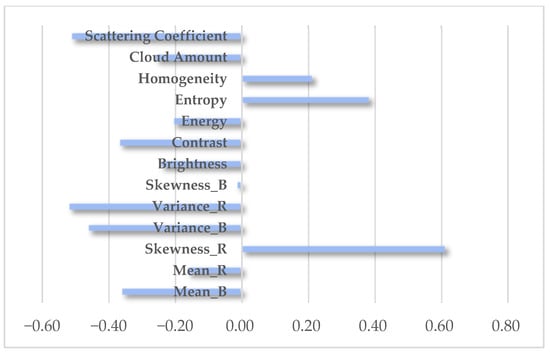
Figure 9.
Spearman correlation coefficient between the feature sequences and the PV power.
Based on the calculated results, it can be observed that the varying impact of different characteristics on photovoltaic power occur in hazy weather. Notably, the correlation index between the photovoltaic power and scattering coefficient is −0.51, indicating a moderate negative correlation. This value surpasses the correlation index of −0.26 between cloud cover and photovoltaic power. Thus, in hazy weather conditions, atmospheric aerosols exhibit a more substantial influence on photovoltaic power compared to their influence in cloud cover conditions.
For subsequent forecasting, this study establishes a correlation threshold of 0.2. Features with a correlation below this threshold are filtered out based on their B skewness and R average values. The remaining features are retained as inputs for the model.
6.3. Model Hyperparameter Tuning
The adjustment of hyperparameters in the model has a significant impact on both training and prediction results. This study primarily employs the method of grid search combined with cross-validation for hyperparameter tuning. The specific tuning processes for the three models are as follows:
- (1)
- LSTM
It is known that increasing the number of layers enhances its learning capacity; however, an excessively large number of layers can hinder network convergence during training. Therefore, in this study, the network is configured with two layers. The optimization ranges for the other hyperparameters are as follows:
Epoch: 45, 80, 100; Number of Neurons in the Hidden Layer: 32, 64, 128, 256; Batch Size: 8, 16, 32, 64; Learning Rate: 0.001, 0.0001; Optimization Algorithm: Adam, SGD;
- (2)
- SVM
The key considerations of SVM involve the selection of the kernel function and the penalty coefficient. The appropriate kernel function can facilitate better linear separation of data in a new feature space while the penalty coefficient, if too large or too small, can affect the model’s generalization performance. Specifically, the optimization ranges for the parameters are as follows:
Kernel Function: Polynomial kernel, RBF kernel; RBF Kernel Function Coefficient: 0.1, 0.2, 0.4, 0.6, 0.8, 1.6; Penalty Coefficient: 0.1, 1, 10;
- (3)
- XGBoost
In the XGBoost model, critical factors affecting performance include the learning rate, maximum tree depth, and random subsample ratio. As the maximum tree depth significantly influences the final results, it is the first parameter to be optimized, with a range of 3–7. After determining the maximum tree depth, the following parameter combinations are explored:
Learning Rate: 0.5, 0.1, 0.01; Epoch: 30, 55, 80; Random Sampling Rate: 0.7, 0.8, 0.95; Solve Method: gbtree; Loss Function: reg:linear.
Through experiments, the final parameter tuning results for the three models are shown in Table 2, Table 3 and Table 4.

Table 2.
LSTM parameters.

Table 3.
SVM parameters.

Table 4.
XGBoost parameters.
6.4. Forecast Results
6.4.1. Prediction Results of Photovoltaic Power in Haze Weather
After obtaining the feature dataset and constructing the aforementioned three prediction models, the computational platform MATLAB 2020 was utilized for model development. We choose to conduct short-term forecasting of photovoltaic power for the next 5 min. The forecasting approach is as follows:
(1) Utilize the extrapolation results of ground-based cloud images for the next 5 min; these have been obtained from our previous work [20];
(2) Real-time extraction of feature sequences from the extrapolated images, using both the feature sequences and historical photovoltaic power values as inputs for the prediction.
To visually demonstrate the enhancement in PV power prediction accuracy achieved by the proposed model under hazy weather conditions, this study selected 21 April 2021 (characterized by heavy haze and increased cloud cover) and 25 April 2021 (featuring light haze and complex cloud conditions) as the forecast dates. Subsequently, the LSTM, SVM, and XGBoost models were employed for prediction. The comparisons between the predicted values and the actual values for each model are presented in Figure 10.
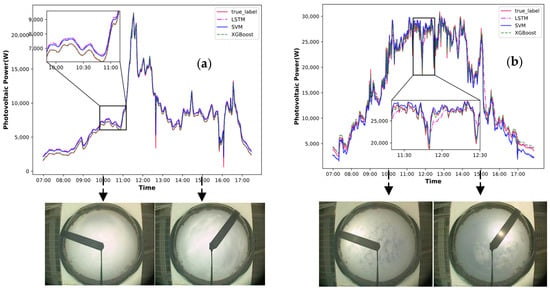
Figure 10.
Forecast results of photovoltaic power under heavy haze weather conditions: (a) 21 April 2021 (characterized by heavy haze and increased cloud cover); (b) 25 April 2021 (featuring light haze and complex cloud conditions).
As shown in Figure 10a, due to the occurrence of a heavy haze event on that day, the sky was predominantly covered by clouds. This led to a more pronounced interaction between aerosols and clouds, as well as a significant aerosol radiation effect. Consequently, the photovoltaic power remained at a low level throughout the day, with substantial overall fluctuations. Upon examining the prediction curves of the three models, it becomes evident that the XGBoost model demonstrates a higher degree of alignment with the true values compared to the LSTM and SVM models. It effectively captures the changing trend of photovoltaic power, showcasing superior prediction performance.
In Figure 10b, the photovoltaic power exhibits minor random fluctuations throughout the day. Upon observation of the ground-based cloud image, it becomes evident that the haze concentration was low on this particular day and the cloud conditions were notably more complex. While the model may not perfectly align with the PV output, it does exhibit the capability to detect sudden drops in PV power and demonstrate a certain level of tracking ability. The actual power generation values in the figure display multiple peaks, with the XGBoost model outperforming the other two models, showcasing robust anti-interference and generalization capabilities.
The results of the further assessment and analysis are presented in Table 5. It is evident from the results that the XGBoost model displays the smallest prediction error and the most accurate prediction performance under both heavy haze and light haze conditions, followed by the SVM model. Taking the coefficient of determination () as an example, the prediction accuracy of XGBoost under heavy haze is 0.99492, surpassing that of the SVM and LSTM models by 0.413% and 0.862%, respectively. Similarly, under light haze conditions, the prediction accuracy of XGBoost is 0.99754, exhibiting an improvement of 0.447% and 2.294% over the SVM and LSTM models, respectively.

Table 5.
Comparison of model evaluation results.
Regarding the central emphasis of this study on extracting cloud features from ground-based images in hazy weather conditions, we have placed significant focus on the comparative analysis of feature extraction methods with existing techniques. The experimental protocol is detailed as follows:
Initially, a diverse array of methods is deployed for cloud feature extraction, succeeded by training with the highly performing XGBoost model. Finally, an assessment of the average photovoltaic prediction results is undertaken, enabling a precise quantitative comparison of the predictive capabilities. The experimental outcomes are detailed in Table 6.

Table 6.
Comparison of average photovoltaic power prediction results.
According to the results in Table 6, it can be observed that after applying the feature extraction method proposed in this study to the dataset, the photovoltaic power prediction model demonstrates higher accuracy.
6.4.2. The Effect of the Scattering Coefficient Feature on the Prediction Results
To confirm the beneficial impact of the defined aerosol scattering coefficient feature on PV power during hazy weather conditions, and to investigate its influence on the prediction accuracy of PV power under good air quality, the following experiments were devised.
Initially, two distinct sets of features were employed as individual inputs for separate training:
: all characteristic data, including the scattering coefficient;
: characteristics excluding the scattering coefficient.
Subsequently, two days characterized by hazy weather and one day with cloudy and haze-free conditions were chosen for forecasting. The optimal model, XGBoost, was employed for training. The prediction results are depicted in Figure 11 and Figure 12.
- (1)
- Case of Haze Weather
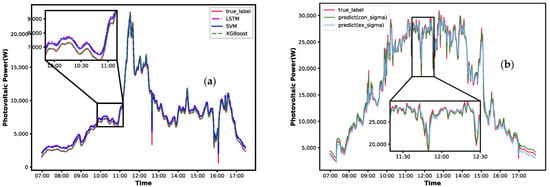
Figure 11.
Comparison results of different feature combinations under haze weather conditions: (a) 21 April 2021 (characterized by heavy haze and increased cloud cover); (b) 25 April 2021 (featuring light haze and complex cloud conditions). (Note: “predict(con_sigma)” signifies that the training process excludes the aerosol coefficients; “predict(ex_sigma)” signifies that the training process includes the aerosol coefficients).
- (2)
- Case of Clear Weather
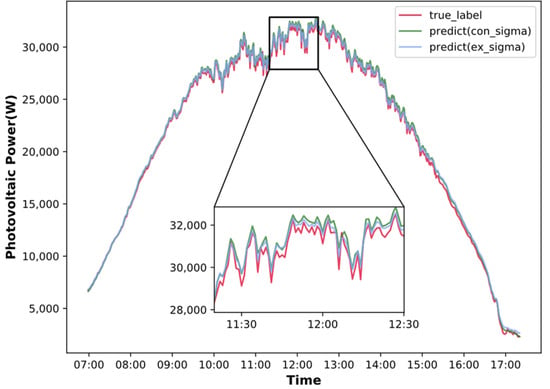
Figure 12.
Comparison results of different feature combinations under clear weather conditions.
Figure 11a illustrates the comparison of PV predicted output curves during heavy haze weather, obtained after training with two feature sets: one encompassing all features, and the other excluding the aerosol scattering coefficient. Meanwhile, Figure 11b presents the comparison of PV predicted output curves for light haze weather, also obtained with these two feature sets. A closer examination of the zoomed-in areas within the figure reveals that the aerosol scattering coefficient characteristic leads to a prediction curve that aligns more closely with the true values, resulting in enhanced model performance.
In Figure 12, it can be observed that the prediction results derived from training with the two feature sets for cloudy weather conditions. Upon closer inspection of the detailed zoomed-in areas within the figure, it is evident that both prediction curves closely match the actual values. Table 7 provides the evaluation indices for the forecast results across the three weather conditions.

Table 7.
Evaluation indices of prediction results under three weather conditions.
The results in Table 7 indicate that under hazy weather conditions, , which incorporates all features for prediction, outperforms , which excludes the aerosol scattering coefficient feature. For instance, considering the coefficient of determination (), the XGBoost model achieves a prediction accuracy of 0.99492 under heavy haze. However, when the aerosol scattering coefficient feature is omitted, the drops to 0.98409. Introducing the aerosol scattering coefficient feature leads to an increase in forecast accuracy of 1.083%. Similarly, in the case of light haze, training with all features results in a of 0.99754 for the XGBoost model. Without the aerosol scattering coefficient feature, decreases to 0.99155, leading to a 0.599% reduction in model prediction accuracy. This underscores the effective role of scattering coefficient feature extraction in hazy weather conditions.
Furthermore, when training with all features in cloudy and haze-free weather, the prediction accuracy, in terms of , stands at 0.99663. This figure remains nearly identical at 0.9967, even without introducing the aerosol scattering coefficient. This reaffirms that the proposed aerosol scattering coefficient characteristics play a pivotal role in ensuring the accuracy of photovoltaic power prediction, even when air quality is optimal.
7. Conclusions
In this study, a photovoltaic power forecasting method was proposed to be tailored for hazy weather conditions using ground-based cloud images. Initially, a qualitative analysis of the attenuation effect of haze on the photovoltaic output curve was conducted. Subsequently, upon observing alterations in the foundational cloud image due to haze, various characteristics were extracted. These included the aerosol scattering coefficient; sky cloud cover; and other features that reflect light intensity, sky color information, and texture details. The selection of input feature sequences was conducted using the Spearman correlation coefficient. The training involved the utilization of the LSTM, SVM, and XGBoost models. The results of the prediction revealed XGBoost as the most suitable model for this study, achieving a photovoltaic power prediction accuracy of 0.99492 under heavy haze and 0.99754 under light haze conditions. It was evident that our average prediction accuracy surpasses that of existing technologies. Furthermore, experiments were conducted to validate the effectiveness of predicting aerosol scattering coefficients in hazy weather. The results indicated that the aerosol scattering coefficient enhances the prediction accuracy of photovoltaic power by 1.083% and 0.599%, respectively, under heavy haze and light haze conditions. Notably, it does not affect the prediction performance under a clear sky. This study presents a novel approach to enhance the accuracy of local photovoltaic power prediction during hazy weather conditions.
However, it is important to note that accurately predicting PV power solely based on two-dimensional information from ground-based cloud images has its limitations. Other environmental factors, such as temperature, humidity, and wind speed, which also impact PV power, cannot be monitored through ground-based cloud images. In the future, there are plans to incorporate this additional environmental information into the predictive model to obtain even more precise results.
Author Contributions
Conceptualization, Z.L. and W.C.; methodology, W.C. and X.L.; software, validation, W.C.; formal analysis, Q.Y.; investigation, W.C.; resources, Z.L., B.N. and W.C; data curation, Z.L.; writing—original draft preparation, W.C. and Q.Y.; writing—review and editing, Z.L., W.C., Q.Y. and B.N.; visualization, W.C. and X.L.; supervision, Z.L. and Q.Y.; funding acquisition, Z.L, W.C., Q.Y., X.L. and B.N. All authors have read and agreed to the published version of the manuscript.
Funding
This research was funded by the National Natural Science Foundation (NNSF) of China, Grant number 51677123.
Institutional Review Board Statement
Not applicable.
Informed Consent Statement
Not applicable.
Data Availability Statement
The data presented in this study are available on request from the corresponding author. The data are not publicly available due to confidentiality reasons.
Acknowledgments
Special thanks to all who contributed to writing the manuscript and the reviewers’ suggestions for improving the manuscript’s quality.
Conflicts of Interest
The authors declare no conflict of interest.
References
- Mohamad Radzi, P.N.L.; Akhter, M.N.; Mekhilef, S.; Mohamed Shah, N. Review on the Application of Photovoltaic Forecasting Using Machine Learning for Very Short- to Long-Term Forecasting. Sustainability 2023, 15, 2942. [Google Scholar] [CrossRef]
- Seyyed, A.S.; Bram, H.; Joshua, M.P. A Review of the Effects of Haze on Solar Photovoltaic Performance. Renew. Sustain. Energy Rev. 2021, 167, 112796. [Google Scholar]
- Rahim, N.A.; Mohammed, M.F.; Eid, B.M. Assessment of effect of haze on photovoltaic systems in Malaysia due to open burning in Sumatra. IET Renew. Power Gene 2016, 11, 299–304. [Google Scholar] [CrossRef]
- Neher, I.; Buchmann, T.; Crewell, S.; Evers-Dietze, B.; Pfeilsticker, K.; Pospichal, B.; Schirrmeister, C.; Meilinger, S. Impact of atmospheric aerosols on photovoltaic energy production Scenario for the Sahel zone. Energy Procedia 2017, 125, 170–179. [Google Scholar] [CrossRef]
- Gutiérrez, C.; Somot, S.; Nabat, P.; Mallet, M.; Gaertner, M.Á.; Perpiñán, O. Impact of aerosols on the spatiotemporal variability of photovoltaic energy production in the Euro-Mediterranean area. Sol. Energy 2018, 174, 1142–1152. [Google Scholar] [CrossRef]
- Chu, H.Y.; Gao, Z.Q.; Sheng, S.Q. Photovoltaic power prediction method considering the influence of haze. Hebei Electric Power Tech. 2014, 5, 23–26. [Google Scholar]
- Liu, W.; Liu, C.; Lin, Y.; Ma, L.; Xiong, F.; Li, J. Ultra-Short-Term Forecast of Photovoltaic Output Power under Fog and Haze Weather. Energies 2018, 11, 528. [Google Scholar] [CrossRef]
- Liu, J.; Wang, X.; Hao, X.D. Photovoltaic power generation power prediction based on multidimensional meteorological data and PCA-BP neural network. Power Syst. Clean Energy 2017, 33, 122–129. [Google Scholar]
- Li, Y.Q.; Du, Y.Y. Short-term prediction of photovoltaic power generation based on two-dimensional sequential filling framework and improved Kohonen weather clustering. Electr. Power Autom. Equip. 2019, 39, 60–65. [Google Scholar]
- Feng, Y.; Hao, W.; Li, H. Machine learning models to quantify and map daily global solar radiation and photovoltaic power. Renew. Sustain. Energy Rev. 2020, 118, 109393. [Google Scholar] [CrossRef]
- Park, S.U.; Joo, S.J.; Lee, I.H. The reduction of the global irradiance due to the Asian Dust Aerosols (PM 10) estimated by the observed data in the dust source region of Erdene in Mongolia. Asia-Pac. J. Atmos. Sci. 2019, 55, 459–476. [Google Scholar] [CrossRef]
- Kuo, W.C.; Chen, C.H.; Chen, S.Y.; Wang, C.C. Deep Learning Neural Networks for Short-Term PV Power Forecasting via Sky Image Method. Energies 2022, 15, 4779. [Google Scholar] [CrossRef]
- Gao, R.; Xue, M.Z.; Zhao, Z.; Sheng, W.M. Ultra-short-term solar PV power forecasting based on cloud displacement vector using multi-channel satellite and NWP data. In Proceedings of the 40th Chinese Control Conference (CCC), Shanghai, China, 26–28 July 2021; pp. 5800–5805. [Google Scholar]
- Lu, Z.; Wang, Z.; Li, X.; Zhang, J. A Method of Ground-Based Cloud Motion Predict: CCLSTM + SR-Net. Remote Sens. 2021, 13, 3876. [Google Scholar] [CrossRef]
- Yang, H.; Kurtz, B.; Nguyen, D. Solar irradiance forecasting using a ground-based sky imager developed at UC San Diego. Solar Energy 2014, 103, 502–524. [Google Scholar] [CrossRef]
- Catalina, A.; Alaiz, C.M.; Dorronsoro, J.R. Combining Numerical Weather Predictions and Satellite Data for PV Energy Nowcasting. IEEE Trans. Sustain. Energy 2020, 11, 1930–1937. [Google Scholar] [CrossRef]
- Kansal, I.; Kasana, S.S. Improved color attenuation prior based image de-fogging technique. Multimed. Tools Appl. 2020, 79, 12069–12091. [Google Scholar] [CrossRef]
- Kansal, I.; Kasana, S.S. Weighted image de-fogging using luminance dark prior. J. Mod. Opt. 2017, 64, 2023–2034. [Google Scholar] [CrossRef]
- Zhen, Z.; Wang, F.; Sun, Y.; Mi, Z.; Liu, C.; Wang, B.; Lu, J. SVM based cloud classification model using total sky images for PV power forecasting. In Proceedings of the 2015 IEEE Power & Energy Society Innovative Smart Grid Technologies Conference (ISGT), Washington, DC, USA, 18–20 February 2015; pp. 1–5. [Google Scholar]
- Lu, Z.; Zhou, Z.; Li, X.; Zhang, J. STANet: A Novel Predictive Neural Network for Ground-Based Remote Sensing Cloud Image Sequence Extrapolation. IEEE Trans Geos. Remote Sens. 2023, 61, 1–11. [Google Scholar] [CrossRef]
- Kamadinata, J.O.; Tan, L.K.; Suwa, T. Sky image-based solar irradiance prediction methodologies using artificial neural networks. Renew. Energy 2019, 134, 837–845. [Google Scholar] [CrossRef]
- Scolari, E.; Sossan, F.; Haure, T.M. Local estimation of the global horizontal irradiance using an all-sky camera. Sol. Energy 2018, 173, 1225–1235. [Google Scholar] [CrossRef]
Disclaimer/Publisher’s Note: The statements, opinions and data contained in all publications are solely those of the individual author(s) and contributor(s) and not of MDPI and/or the editor(s). MDPI and/or the editor(s) disclaim responsibility for any injury to people or property resulting from any ideas, methods, instructions or products referred to in the content. |
© 2023 by the authors. Licensee MDPI, Basel, Switzerland. This article is an open access article distributed under the terms and conditions of the Creative Commons Attribution (CC BY) license (https://creativecommons.org/licenses/by/4.0/).








